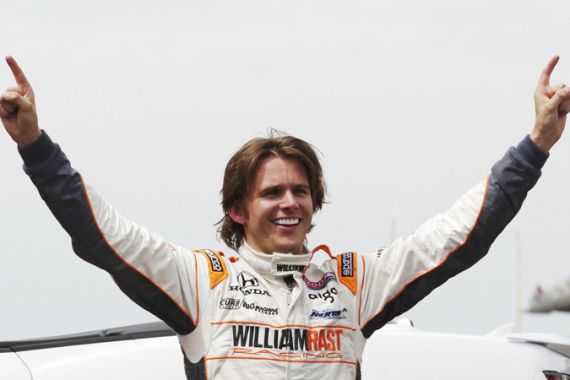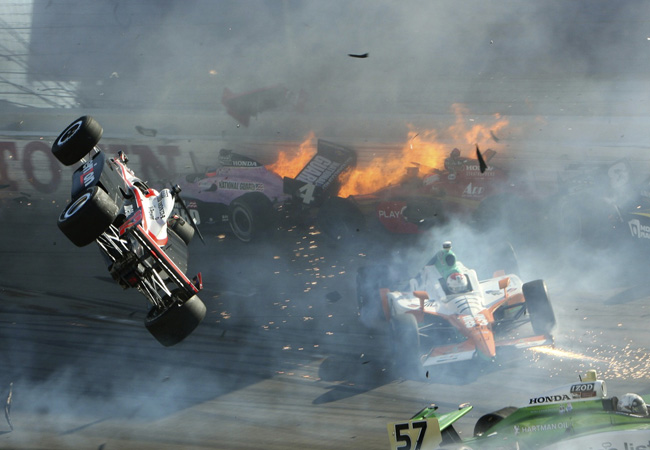‘Perfect storm’ led to Dan Wheldon death
Investigation finds no single factor to blame for death of British IndyCar driver in October.

 |
| The report found that the British driver suffered a ‘non-survivable head injury’ when he crashed [REUTERS] |
Dan Wheldon was killed when his head hit a post in the fencing at the Las Vegas Motor Speedway – contact that created a “non-survivable injury” to the two-time Indianapolis 500 winner.
The cause of death was revealed on Thursday when IndyCar presented its findings of the October 16 accident in the season finale.
Keep reading
list of 4 items‘Mama we’re dying’: Only able to hear her kids in Gaza in their final days
Europe pledges to boost aid to Sudan on unwelcome war anniversary
Birth, death, escape: Three women’s struggle through Sudan’s war
The crash collected 15 cars, including Wheldon, who came from behind the initial contact, launched over spinning cars and sailed about 325 feet into the catchfence.
Although the contact with the post killed Wheldon, the investigation determined several factors contributed to what became a “perfect storm.”
“The accident was significant due to the number of race cars damaged, but more importantly due to the non-survivable injuries to Dan Wheldon,” the report said.
“While several factors coincided to produce a “perfect storm,” none of them can be singled out as the sole cause of the accident.
“For this reason, it is impossible to determine with certainty that the result would have been any different if one or more of the factors did not exist.”
Finale
The race had a season-high 34 cars, but IndyCar CEO Randy Bernard said Thursday the field could have had as many as 37 drivers based on the size of both the track and the pit lane.
The season finale was held on Vegas’ high-banked 1.5-mile oval with multiple racing grooves, which IndyCar president Brian Barnhart said created “nearly unlimited movement on the track surface under race conditions.”
That, not the construction of the fencing, played a larger role in Wheldon’s death.
Barnhart admitted IndyCar was not prepared for the drivers to have free reign on a wide-open race track.
Most ovals have only one or two racing grooves, which the report said “restrict drivers’ naturally aggressive racing behaviour (and) make the location of other competitors’ cars on the race track predictable.”
Because this was IndyCar’s first visit to Las Vegas since 2000, the majority of the field was not experienced on the variable banking or wide surface.
But drivers did predict racing at Las Vegas could be hairy as early as preseason testing. Marco Andretti was one of the first drivers to publicly question the track, which would “be easily wide open, which is going to create a big pack. It’s going to be fun for the fans. I like those races, but it’ll be dangerous.”
That mantra was repeated in the build-up to Las Vegas by many top-name drivers and all weekend as speeds inched toward 220 mph in practice sessions. Yet IndyCar was surprised when the race began.
“I don’t think we were expecting it to be any different from what we’d experienced in the last decade at places like Chicagoland, Kentucky, Fontana and Texas; places like that where while there is the ability to run flat and there’s multiple grooves, you couldn’t run from the top of the race track to the bottom,” Barnhart said.
“We were never expecting to be able to run from the top to the bottom (at Las Vegas).”
Unknown conditions
Barnhart stressed IndyCar “never” gets a chance to duplicate race conditions, so no amount of testing or practice would have prepared anyone for what happened when the race began.
Las Vegas Motor Speedway president Chris Powell said track officials will work with IndyCar in hopes “the series might return to LVMS in the future.”
To do that, Barnhart said it was imperative for IndyCar to establish guidelines for the drivers to follow going future on surfaces such as Las Vegas, and the series needs to look at aerodynamic changes that make the cars “more challenging to drive.”
“We need to create a limit,” he said. “They have to understand there is a line they can’t cross.”
IndyCar also addressed the $5 million promotion that featured Wheldon.
Wheldon was making just his third start of the season and chasing the incentive offered by Bernard to any non-IndyCar regular who could drive from the back of the field to win the race. Wheldon would have split the money with a fan selected in a random drawing.
Allowing Wheldon to take the challenge was a stretch – he won 14 races on ovals, including the Indy 500 earlier last season – but because he sat out the season, he technically qualified for the bonus.
Money talks
But Wheldon felt he was up for the challenge.
He was the in-race reporter for ABC during the event, and spoke with the announcers during the warm-up laps. In a brief interview, Wheldon defended his participation and the entire IndyCar Series.
“I wouldn’t be doing this if I didn’t think that I could win,” he said from his car.
“Certainly I am not underestimating the talent of the other drivers in the field. I think IndyCar has got a phenomenal field right now.”
Wheldon was killed minutes later when the crash began ahead of him at the start of the 12th lap. He had picked his way through the field and gained at least 10 spots when he came upon the accident and had nowhere to go to avoid the spinning cars and flying debris.
The report found that although Wheldon stayed low on the race track and appeared to be attempting to avoid the cluster of cars spinning toward the top – he had slowed from 224 mph to 165 – his path was blocked by other cars.
His first contact with another car sent him airborne.
IndyCar plans on judging all high-banked ovals individually going forward and said the Wheldon accident could not be blamed on the banking. That leaves room for a deal to be worked out with Texas Motor Speedway, one of the most popular venues on the IndyCar schedule.
No sanctioning agreement between Texas and IndyCar has been worked out, but Bernard indicated he would like to have the 2012 schedule announced by Friday.